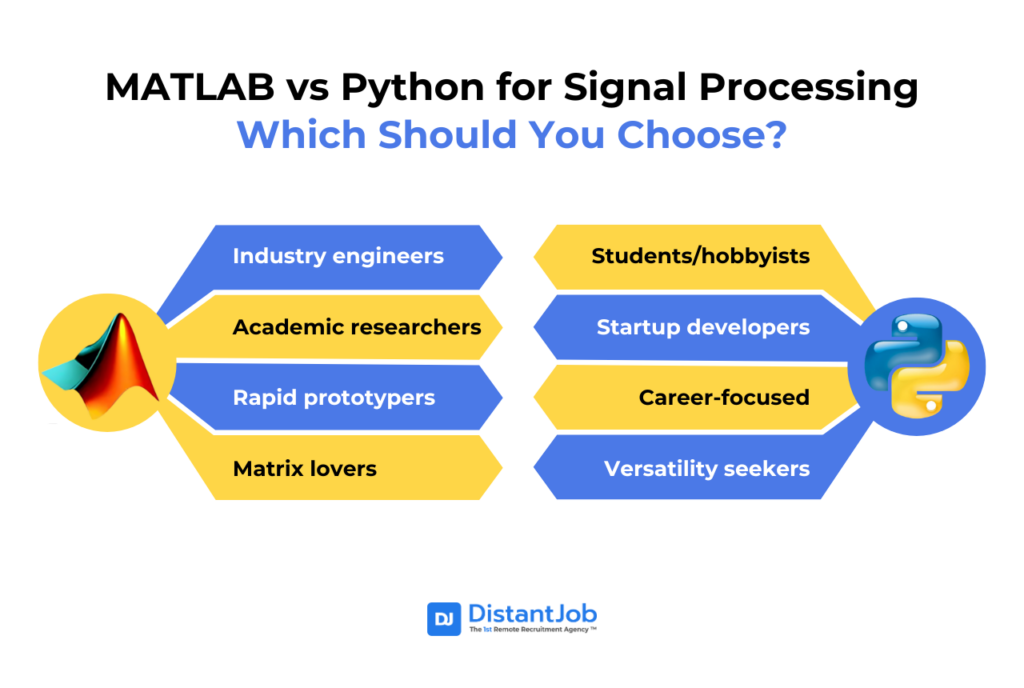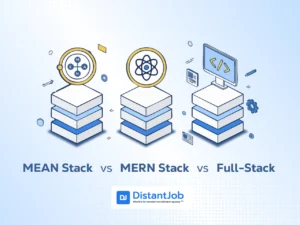For many engineers and scientists, the question “MATLAB vs Python” comes up when starting DSP projects. When it comes to digital signal processing (DSP), both MATLAB and Python are powerful choices.
MATLAB is a specialized engineering platform for heavy-duty signal processing. Python, on the other hand, has surged in popularity thanks to its clear syntax and open-source libraries and is widely used in science and industry.
In this article, we compare MATLAB vs Python in the context of signal processing. We will focus on built-in tools, ease of use, visualization, community support, performance, features’ maturity, and licensing.
What is Signal Processing?
Signal processing analyzes and transforms various types of information (voice, images, data) using techniques like filtering, compression, and recognition. It’s applied in communication, medicine, media, and automation. Digital Signal Processing (DSP) converts analog signals into digital signals, translating them for computer manipulation.
MATLAB vs Python: Libraries and Toolboxes
The difference between MATLAB and Python on libraries and toolboxes is that MATLAB provides a unified, commercial environment with guaranteed compatibility between toolboxes and extensive technical support, while Python offers flexibility through its diverse library ecosystem but requires more manual integration and dependency management.
MATLAB Advantages
MATLAB offers integrated, specialized toolboxes designed specifically for signal processing: Signal Processing Toolbox, DSP System Toolbox, and Communications Toolbox. These provide hundreds of dedicated functions with consistent APIs, comprehensive documentation, and interactive design tools like Filter Designer and SPTool.
Python Advantages
Python leverages a rich ecosystem of open-source libraries, including NumPy for numerical computing, SciPy for scientific functions, and specialized packages like librosa for audio processing and scikit-signal for advanced signal analysis. The modular approach allows users to combine libraries as needed.
MATLAB’s Specialized Toolboxes
This is where MATLAB flexes its muscles. The Signal Processing Toolbox isn’t just comprehensive, it’s ridiculously comprehensive.
Filter design made stupid simple:
- Interactive Filter Designer – Click, drag, done. No coding required for basic filters
- Every filter type – FIR, IIR, adaptive, multirate – all built-in with optimized algorithms
- Real-time tweaking – Adjust parameters and see results instantly
Spectral analysis that actually works:
- Beyond basic FFTs – Advanced spectral estimation techniques ready out-of-the-box
- Frequency domain mastery – Robust tools for analyzing signal frequency content
- Professional-grade algorithms – Industry-tested methods, not academic experiments
Time-frequency analysis wizardry:
- Spectrograms and wavelets – Watch how frequencies change over time
- Advanced visualization – See patterns your raw data hides
- Multiple analysis methods – Pick the right tool for your specific signal type
Feature extraction goldmine:
- Automated measurements – Extract peaks, power, bandwidth, and distortion with a single command
- ML-ready features – Perfect for feeding into machine learning pipelines
- Signal characterization – Understand your data without manual analysis
Signal generation and cleanup:
- Test signal creation – Generate any signal type for testing algorithms
- Preprocessing pipeline – Denoising, smoothing, detrending, all built-in
- Professional workflows – Industry-standard preprocessing methods
Interactive apps that save hours:
- Signal Analyzer – Visualize and explore without writing code
- Signal Labeler – Perfect for creating AI training datasets
- Point-and-click insights – Get results fast, code later if needed
Bottom line: MATLAB’s toolboxes are like having a team of DSP experts built into your software. Python can do it all, too – but you’ll be building what MATLAB already perfected!
Python’s Versatile Libraries
On the other hand, Python’s greatest strength is its adaptability. It’s used for web development, data analysis, artificial intelligence, machine learning, and, yes, signal processing. Learning Python means acquiring a highly adaptable skill that opens doors to many different career paths and project types.
For DSP purposes, Python relies on open-source libraries. While Python doesn’t have a single “Signal Processing Toolbox” like MATLAB, it boasts an incredible collection of specialized libraries that collectively provide powerful DSP capabilities.
NumPy
The fundamental package for numerical computing in Python. It provides efficient array objects and functions for working with them, which is crucial for handling signal data.
SciPy
Built on NumPy, SciPy provides a vast array of scientific computing tools, including a dedicated scipy.signal module for signal processing. This module offers functions for filtering, spectral analysis (like FFT), and various other DSP operations.
PyWavelets
As the name suggests, this library is specifically designed for wavelet transforms, offering 1D, 2D, and nD Discrete and Continuous Wavelet Transforms, and often provides results compatible with MATLAB’s Wavelet Toolbox.
Matplotlib
Matplotlib is a highly flexible plotting library that can produce publication-quality figures for visualizing signals in time and frequency domains. However, it requires more coding than MATLAB for interactive plots. Libraries like Bokeh or Qt bindings can be used for more interactive visualizations, though they add complexity.
Librosa
Specifically designed for audio and music signal processing, Librosa provides tools for tasks like spectral analysis, beat tracking, and feature extraction from audio signals.
PyAudio
This library facilitates audio input and output, providing a cross-platform interface to interact with audio hardware, which is useful for real-time audio processing and applications.
PyWavelets
For tasks involving wavelet analysis, PyWavelets offers a range of wavelet transforms and utilities for signal decomposition and analysis in the wavelet domain.
How easy is MATLAB vs Python for DSP beginners?
MATLAB wins for immediate DSP work, while Python excels for long-term programming skills development.
MATLAB’s ease of use advantages
MATLAB is a computer program made for engineers. It’s like a powerful calculator.
For example, MATLAB speaks math: You can type things almost exactly how you’d write them in a math problem. For example, to make a list of numbers from 1 to 10, you just type [1:10].
You can also easily create and work with lists of numbers (called vectors) and tables of numbers (called matrices). You can even multiply them together directly.
MATLAB has different sections on its screen that help you. There’s a window where you type commands, another that shows you your work, and a window that shows you graphs and charts. This makes it simple to try out different calculations and see the results quickly.
Basically, MATLAB is designed to be simple and natural for anyone who deals with numbers and math, like scientists and engineers, even if they’re just starting out.
However, if you are not one of them, it might get harder quickly.
For DSP, MATLAB often feels straightforward because many functions (like FFT or filters) are one-liners. Many students learn DSP using MATLAB first, thanks to the low barrier to entry.
Python’s learning curve considerations
Python’s syntax is simple, readable, and often recommended for beginners, as it closely resembles natural language. This allows new programmers to focus on problem-solving rather than complex syntax. Blocks are defined by indentation, and code “reads” similarly to pseudocode, which many find easy to follow. While you can perform similar array math (using NumPy), some operations require calling explicit functions (e.g., numpy.dot for dot products).
Setting up Python for DSP involves installing libraries (via package managers or distributions like Anaconda), which is an extra step. However, Python’s versatility is a plus: if you’re also interested in web or data projects, Python is the same language. Overall, beginners may initially prefer MATLAB’s one-stop environment, but Python’s syntax is considered clear and easy to learn for a larger audience.
Bottom line: MATLAB gets you doing DSP faster, but Python teaches you programming skills that transfer beyond signal processing.
Visualization and Interactive Tools
Be specific about the visualization capabilities you need, from instant plot generation to interactive filter design superpowers. Plus, mention the complexity level (basic plotting, advanced GUI tools, or visualization Jedi status) and any domain-specific requirements you’re craving.
MATLAB delivers plotting power straight out of the box – call plot(t, signal) and instantly see your waveform come to life. It also includes higher-level GUIs: SPTool for signal analysis and Filter Designer (FDATool) for designing and visualizing filters graphically.
MATLAB’s integrated development environment (IDE) is highly interactive, with a user-friendly interface ideal for visualizing data, debugging scripts, and instantly testing code. Its plotting functions are highly customizable, offering advanced visualization options.
Bottom line: MATLAB dominates visualization, especially when you need interactive plot tweaking and real-time filter adjustments.
Python leverages specialized libraries for visualization muscle. Matplotlib leads the charge – explicitly modeled on MATLAB’s plotting DNA but with Python flexibility. It recreates nearly every MATLAB plot (plus countless more) with fine control. Interactive features like zooming and panning come standard, and it embeds seamlessly in Jupyter notebooks for live analysis sessions.
Community and Ecosystem
MATLAB has a long-established user base, especially in engineering and research. It’s said to have millions of users worldwide, with strong adoption in universities and industry. That means a vast library of example code and many textbooks use MATLAB conventions. Support is available from MathWorks (live technical support, official documentation) as well as user-driven forums (MATLAB Answers, File Exchange).
Python’s community is larger overall because Python spans every field of programming. For DSP specifically, many resources exist in the open-source sphere: forums, blogs, and Q&A sites. StackOverflow and dsp.stackexchange have thousands of questions on Python signal-processing topics. The SciPy community (for scientific computing in Python) also provides documentation and mailing lists. In general, it’s easy to find help online for Python DSP tasks, since Python’s popularity means more peer support.
In short, MATLAB’s community support is more specialized (dedicated DSP and engineering forums), while Python’s support is broader and fast-growing (covering DSP as one of many applications). Both have active forums: Python users often rely on StackOverflow and community docs, whereas MATLAB users have official channels plus the very active MATLAB Answers forum.
Performance for DSP Tasks
For heavy numerical work (like long FFTs or large filter banks), performance is crucial. MATLAB was historically optimized for fast array math, and it excels at vectorized operations. Its core routines (FFT, matrix multiply) are multi-threaded and use highly tuned libraries. Python can be just as fast if you use the right libraries. NumPy and SciPy are implemented in C/Fortran and often use the same optimized math libraries as MATLAB.
Mike Rosam, a former Head of Innovation from McLaren, notes that the old speed gap has largely vanished – “In post-2018 versions of MATLAB, the JIT compiler accelerated loops dramatically, making Python’s loops look irredeemably slow in comparison”.
For most standard DSP algorithms (FIR filters, FFTs, convolutions), Python with NumPy/SciPy runs at comparable speed to MATLAB when code is vectorized.
Where performance might diverge is in non-vectorized code: pure Python loops are slower than MATLAB’s array operations. On the other hand, Python offers just-in-time and compiled extensions (Numba, Cython) to speed up custom code if needed.
MATLAB offers its own code-generation tools (MEX files, GPU, and parallel toolboxes) for acceleration. In practice, neither platform always wins: benchmarks show that “for most real-world applications, neither has a significant speed advantage over the other”.
The key here is to leverage optimized libraries: using built-in DSP functions in MATLAB or NumPy/SciPy in Python will give similarly fast results.
Maturity of DSP Features
Since MATLAB was born in the 1980s, its DSP features are very mature. Its Signal Processing and Communications toolboxes have been refined through many releases, covering a broad range of algorithms and edge cases.
Many classic DSP functions (filter design with various windows, spectral analysis functions like pwelch, zero-phase filtering, etc.) are built-in and well-tested. When a niche capability is needed, MATLAB often has it as part of an add-on toolbox.
Python’s DSP libraries came much later (SciPy originated in the early 2000s), but they have been catching up quickly. The core signal module now includes filters, windowing, spectral methods, and transform routines. Additional packages bring more features (for example, pyroomacoustics for acoustics, or community packages on GitHub).
MATLAB is still ahead in breadth of built-in DSP functionality, but the gap is closing. Many DSP algorithms can be implemented in Python with libraries plus a bit of coding. Since Python libraries are open source, they also evolve rapidly, often via community contributions.
In summary, MATLAB’s DSP tools benefit from longer development and integration, while Python’s tools are younger but very active. For standard tasks, both have you covered. For specialized needs, MATLAB’s official toolboxes may have an immediate solution, whereas in Python, you might need to search for a library or implement it manually.
Licensing and Access
When you’re deciding between Python and MATLAB for your programming needs, licensing might be the biggest difference you’ll encounter, because MATLAB is commercial software, while Python is free.
A single-user license for MATLAB costs thousands of dollars, and each specialized toolbox (like Signal Processing Toolbox) is an extra purchase. Many companies and universities buy group licenses, but those still come at a significant cost. In other words, access to MATLAB’s DSP features requires having a valid license. (MathWorks, the company behind MATLAB, does offer student and home licenses at a lower cost, but these are limited.)
Python is free and open-source. You can download Python and its DSP libraries (NumPy, SciPy, Matplotlib, etc.) at no cost. There are no license fees per user or per toolbox. This makes Python very attractive for hobbyists, startups, or educational settings without big budgets.
The open-source licenses also allow users to inspect and modify the code. The trade-off is that Python’s tools are assembled piecemeal, rather than a single integrated package, but installing a scientific Python distribution (like Anaconda) can simplify setup.
In terms of availability, many schools and labs already have MATLAB, so students might encounter MATLAB first. Conversely, anyone can easily try Python on their own computer. This cost/access factor often tips newcomers toward Python if funding is a concern, and toward MATLAB in well-funded engineering environments.
MATLAB vs Python Differences Comparison Table
This table shows the MATLAB vs Python differences in ecosystem, ease of use, visualization, documentation, community, performance, and costs.
Python wins for beginners, budget-conscious users, versatile applications, and open-source preference, while MATLAB wins for engineering professionals, specialized mathematical computing, and integrated toolbox requirements
| Aspect | MATLAB | Python |
| Ecosystem | All-in-one platform: specialized DSP apps, Simulink | Open ecosystem: pick libraries (NumPy/SciPy, etc.) |
| Ease of use | Intuitive for math; many built-in apps | Clear syntax; requires library setup |
| Visualization | High-quality default plots and filter design GUIs | Matplotlib for plotting; notebooks for interactivity |
| Documentation | Extensive official docs and support | Documentation varies; many tutorials and forum Q&A |
| Community | Strong in academia/industry; official support | Huge open-source community; StackOverflow, SciPy forum |
| Performance | Optimized linear algebra and DSP routines | Comparable speed with optimized libraries |
| License/Cost | Proprietary, paid licenses | Open-source, free (BSD/PSF license) |
Which Should You Choose?
Neither is “better” – they’re tools for different jobs. Pick based on your situation, not internet debates.
Choose MATLAB if you’re:
- Industry engineers – Your company already pays for licenses, and you need those polished toolboxes
- Academic researchers – Universities have licenses, and you’re doing pure DSP work
- Rapid prototypers – Need instant visualization and mature signal processing apps
- Matrix lovers – Comfortable with MATLAB’s syntax and domain-specific design
MATLAB wins when: You want plug-and-play DSP tools, Simulink integration, and don’t mind paying for premium features.
Choose Python if you’re:
- Students/hobbyists – Free beats are expensive, especially when learning
- Startup developers – Building products that integrate with other systems
- Career-focused – Python skills transfer across industries (tech, pharma, finance)
- Versatility seekers – DSP is just one part of your broader project
It’s also possible to use both together. MATLAB can call Python libraries (and vice versa), so you can leverage MATLAB’s DSP toolbox and Python’s ecosystem in the same project.

Put it simply, MATLAB equals premium DSP experience while Python equals versatile, free, and future-proof. Pick based on your budget, career goals, and project needs – not fanboy wars!
The Smartest Approach: Learn Both!
Many experts and seasoned professionals advocate for a hybrid approach or, at the very least, learning both languages. You might start with MATLAB to grasp the fundamental concepts and quick prototyping capabilities of DSP, then transition to Python to leverage its broader applicability and integrate your DSP knowledge into larger, more diverse projects.
Using both together is also a viable option. Use MATLAB for its sophisticated toolboxes and specialized analysis, and then use Python for deployment, data integration, or machine learning pipelines. While a hybrid workflow might introduce some overhead, it is incredibly powerful when you need the best of both worlds. The best tool is the one that empowers you to solve your problems most effectively.
Conclusion
The best tool is the one that empowers you to solve your problems most effectively. Ultimately, consider your needs: if you must solve DSP problems quickly with minimal setup and money is no object, MATLAB’s DSP toolboxes offer a turnkey solution. If you value open source, a broad ecosystem, or are just starting out, Python is a compelling choice for DSP tasks. Both environments will get the job done.
And if you need a MATLAB developer or a Python developer for your business, and don’t know where to start, we’ve got you covered.





